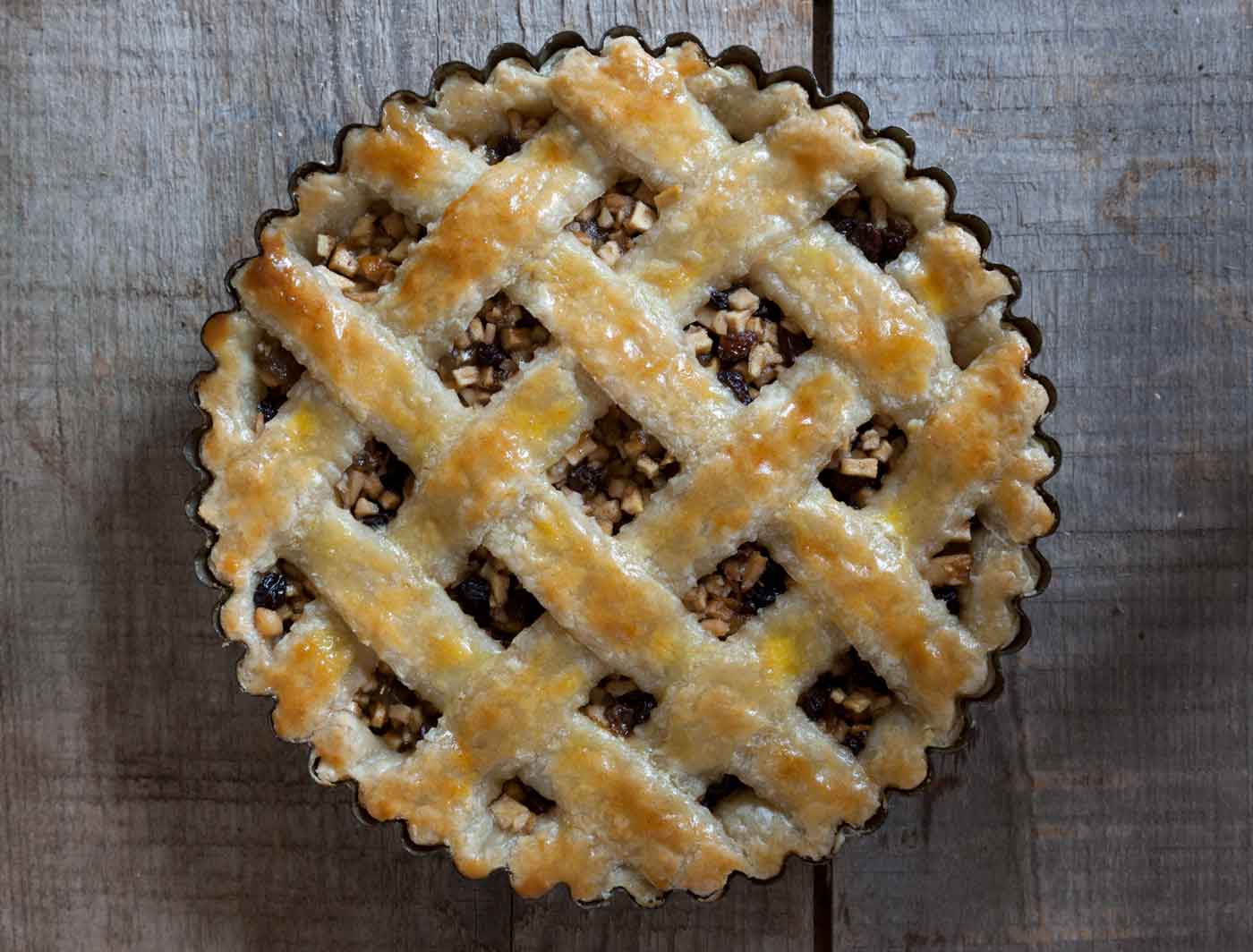Watch our historic foodways staff cook this recipe, then try it at home
Mincemeat pies are a medieval Christmas tradition. Typically, mincemeats are made up several months in advance to allow the flavors to merge. The ever-present alcohol and sugar was a way to preserve meat. By the late 18th century the meat component had become optional.
18th Century
Take three pounds of suet shred very fine, and chopped as small as possible; two pounds of raisins stoned, and chopped as fine as possible; two pounds of currants nicely picked, washed, rubbed and dried at the fire; half a hundred of fine pippins, pared, cored and chopped small’ half a pound of fine sugar pounded fine; a quarter of an ounce of mace, a quarter of an ounce of cloves, two large nutmeg, all beat fine; put all together into a great pan, and mix it well together with half a pint of brandy, and half a pint of sack. Put it down close in a stone pot and keep it for four months
— Glasse, Hannah “The Art of Cookery Made Plain and Easy”
21st Century
Ingredients
- Pastry (homemade or store bought)
- 1 pound beef suet*
- 4 large Granny Smith apples
- ½ lbs. raisins
- ½ lbs. currants
- 2 oz. candied lemon peel
- 2 oz. candied orange peel
- 1 cup brown sugar
- ½ tsp. mace
- ½ tsp. nutmeg
- ½ tsp. cloves
- 1 pound of finely chopped almonds**
- ½ to 1 cup of brandy
- ½ to 1 cup of sweet sherry
Instructions
- Mince the suet, peeled and cored apples, raisins, currants, candied lemon and orange peels, and place filling into a large bowl.
- To the filling, add the sugar, mace, nutmeg, cloves, almonds (if using) and sherry. Mix thoroughly with your hand or spoon.
- Place in a large crock, or tall plastic container. Add enough brandy and sherry so that the entire mixture is just covered. Let sit in a cool area for at least three months.
When you are ready to make your pies:
- Preheat the oven to 450°.
- Remove one piece of dough from refrigerator and let stand until soft.
- Lightly flour your work surface and roll out dough into a 12-inch circle. Then, wrap the dough around the rolling pin to transfer into a 9-inch pie pan. Unwrap the dough from the rolling pin into the pie pan, making sure the dough is form-fitted to the pan. Allow the dough to overhang the lip of the pan. Return pie pan with dough to the refrigerator until it is needed
- Retrieve the pie pan from the refrigerator. Fill the pie with the mixture.
- Roll out the second piece of pastry into a rectangle. Cut 3/4 inch to 1 inch strips along the length of the pastry to give you eight strips. Weave a lattice top for your pie. With a little flour and water, “glue” each strip edge to the bottom pastry at the plate’s rim. Trim any excess. Using a whipped egg yolk, gently glaze the top lattice using a pastry brush. This will lightly brown the top. If you do not wish to make a lattice, take your pastry and make a full top crust as you do for any fruit pie.
- Place a rimmed baking sheet on the middle rack of the oven. Place the pie in the middle of the sheet. Bake at 450° for 10 minutes, then at 350° for 35-45 minutes.
- Allow pie to rest at least half an hour before slicing.
*Beef suet can usually be found in grocery stores around the December holidays. If you cannot find it on display you can usually ask the butcher shop manager to order some for you. If that isn’t an option, any hard fat taken off a good quality steak will do. Simply collect the fat and freeze it until you with to make the pudding. The suet does not taste like beef, but will give the pies a lovely, creamy mouth feel.
** Though not found in this version of the recipe a pound of finely chopped almonds is included in later editions. It makes a lovely addition to the taste of the mince.
